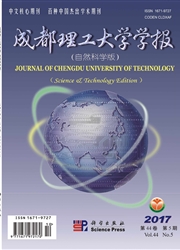

 中文摘要:
中文摘要:
西藏北部雁石坪地区中侏罗统夏里组是一套以砂岩、泥岩为主夹少量灰岩、膏盐岩组成的潮坪环境沉积,以发育极好的米级旋回为特征。根据地层颜色、岩性及岩相将此套地层划分成85个米级旋回,分为碎屑岩型、碎屑岩-碳酸盐岩型2种类型。其中碎屑岩型旋回包括12种亚类型,碎屑岩-碳酸盐岩型包括2种亚类型,它们具有的共同特征是颗粒向上变细、沉积环境总体向上变浅,以潮汐的“正粒序”为特征。通过频谱分析技术对米级旋回叠置规律研究发现,夏里组中主要旋回与米兰科维奇旋回周期之间具有很好的对应关系,该套旋回地层的形成受米兰科维奇旋回的控制。
 英文摘要:
英文摘要:
The Middle Jurassic Xiali Formation characterized by meter-scale cycles in the Yanshiping area of North Tibet is a suite of tidal-flat deposits composing mainly of sandstone, mudstone, minor limestone and saline deposits. Based on the color, tithology and rock facies, the strata are divided into 85 meter-scale cycles, and all the cycles can be further divided into clastic rock and clastic rockcarbonate meter-scale cyclic sequences. The clastic rock meter-scale cyclic sequence includes 12 sub- types, the clastic rock-carbonate meter-scale cyclic sequence includes 2 sub-types. Their common characters are that the grains become fine upward. This coincides with that the depositional environment becomes shallow upward, characterized by the positive graded bedding formed by the tides. Finally, through studying the superimposed laws of the meter-scale cycles by spectrum analysis, the main cycles in Xiali Formation are in a very good correspondence with the Milankovitch cycles and the researched cyclic sequences are controlled by the Milankovitch cycles.
 同期刊论文项目
同期刊论文项目
 同项目期刊论文
同项目期刊论文
 The calcareous nannofossils record and its geological significance in the Jurassic black shales from
The calcareous nannofossils record and its geological significance in the Jurassic black shales from 期刊信息
期刊信息
